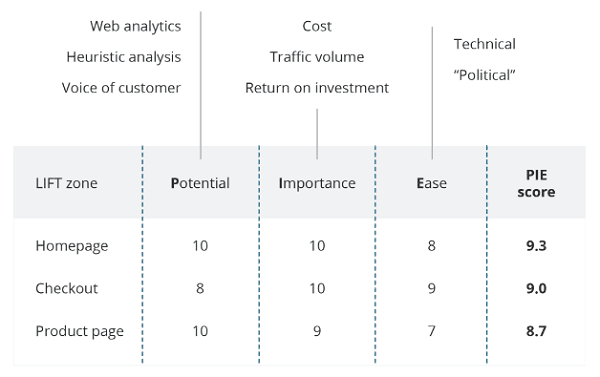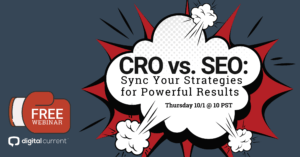It’s science (OK, and math): incremental improvements in CRO add up to compounding revenue gains over the longterm.
But how do you tackle conversion rate optimization efficiently, using data—not instincts and wild guesses—to drive your A/B testing priorities?
There’s 3 basic steps you should take to improve user experience and, ultimately, grow more revenue through CRO.
What Is Conversion Rate Optimization: A Refresher
Conversion Rate Optimization is the data-driven process of figuring out how users interact with your site, what their needs are and how to convince them to either:
1) give you their money (in the case of eComm and retail goods) OR
2) give you their contact information (on a lead gen site).
Whether you’re in eComm or lead generation, the end goal of CRO is the same: get more conversions out of your existing site traffic.
By leveraging CRO data, you can run experiments called A/B tests, using psychologically proven principles to boost conversions on your site.
Conversion optimization is an ongoing marketing practice that’s never fully completed. As sales and marketing goals shift and evolve, so does a site’s ongoing CRO strategy. But understand this: no website is ever “done” optimizing.
Whether you have a simple website with only a handful of pages, a large, complex website — or even a few sites — conversion optimization can often feel like a difficult, time-intensive task. But you can avoid the feeling that you’re optimizing in circles if use data to vet your testing opportunities and rank them against one another.
1. Use Data to Identify CRO Opportunities
Here’s where you should start: What conversions are most important to your sales and marketing strategy?
Form-fills? Purchases? Abandoned carts? Newsletter sign-ups? eBook downloads?
It depends on your business goals, so let them guide you. Look at conversion rates across your Google Analytics goals to determine which optimizations might make the largest impact.
Then take your research a step further: use Google Analytics to generate a report on the pages that drive the most traffic.
When optimizing, it’s important that a significant amount of people visit a particular page to ensure the sample size is large enough to prove if a change had any impact. (If you’re not getting the traffic you need, that’s another problem — and we’ve got solutions for that, too — you may want to tackle first.)
Here’s how you find your best-trafficked pages In Google Analytics: visit the Behavior > Site Content > All Pages. Reference the Pageviews and unique Pageviews columns to find the most trafficked pages on your website. Look at Bounce Rates—what are the highest and lowest on the list of pages? Look at Time on Page. Are people spending less than 30 seconds on a page where you want them to convert? That’s an issue.
That’s how your analysis begins.
As a general rule, you’ll want to look at pages with at least 1,000 pageviews per month (consistently — don’t let a banner month skew your results). Less than that, and CRO is hard to accomplish, since the sample size is just too small — in that case, you’re better off reviewing your audience targeting and engagement strategy, as you may have a different marketing problem. Essentially, the more traffic you have, the less time you need to run your tests to get actionable results. You can still do CRO at the lower end of the pageview count spectrum, but you’ll have to commit to running a test for weeks or months, rather than a few days. You need statistically significant data.
Next: Make sure your data analysis shows which conversions are most important to your business. Create another Google Analytics report highlighting the pages that drive the most conversions. (Make sure you can determine the results each page is driving by setting up goal tracking.) Check out the reports in Conversions > Goals > Overview.
In your conversion reports, look at the number of goal completions, their conversion rates, and compare that to the monetary value of each goal. If you’re in eComm, how much is your AOV? If you’re in lead gen, what’s an MQL or SQL worth to you? What’s your LTV?
Conversion rate is calculated by dividing conversions by traffic. So, if 100 conversions happen on a page with 1,000 pageviews, your conversion rate is 10%. This is your benchmark — what you’re trying to improve, ideally, and what you’ll judge your tests by.
Google Analytics is a must for identifying CRO opportunities, but there are additional tools to help you do thorough research for testing. Check out our favorite 6 CRO tools to boost conversions.
What’s the end goal of all this data? A list of highly trafficked and high-converting pages— pages that offer CRO testing opportunities that are truly worth your time.
2. Ask the Right Questions
Now, it’s time to focus your CRO goals and brainstorm testing ideas.
Examine the content and design of the highly trafficked and high-converting pages you identified from your research. It’s time to take a step back and get perspective.
Put yourself in the customer’s shoes and look for faults in the flow of your website’s buyer’s journey and UX.
Put your marketing hat back on and ask what part of your funnel isn’t working well. Which KPIs aren’t you hitting?
You’re the Sherlock Holmes of the digital marketing world right now. So be critical and look at small details. The questions you’re asking now about your site content inform the basis of your tests.
Your data and observations about the pages should lead you to questions like these:
- Are there too many fields on an important form?
- Are CTA buttons in the right spot?
- Do design elements make it difficult to read a page?
- Do pages clearly communicate where the user is and push them to take an action?
- Pretend you have never seen your own site before. Would you understand the product quickly?
Nitpick your own website, and you’re sure to find questions that lead to testing hypotheses—hypotheses you can prove or disprove with data through A/B testing.
Altering variables across your website with A/B testing is one of the most effective ways to see what changes will have the biggest impact on the number of conversions driven.
“The most common challenge companies face is collecting and organizing questions, or hypotheses, to guide testing,” says Brian Massey, founder of Conversion Sciences and author of Your Customer Creation Equation.
“Success with testing changes across your website is best achieved by answering questions with data,” says Massey. “Testing is a great way to collect data, but it takes time and effort.
“That means you have to be asking good questions, or your answers will be useless,” he says. “It’s best to take the time to look at all your pages and fill a spreadsheet with ideas that could increase conversion rates. Then, you can rank these questions.
“Is there a part of the site that you have many ideas about? For example, if you have lots of ideas for improving the cart, that may be the right place to start collecting data for testing.
“Let the questions be your guide,” he adds. “Go through the ranking process and test those things that have the most promise of delivering an ROI on your testing efforts.”
This isn’t a perfect process, as it requires ongoing trial and error to see which action is actually worth investing time and resources into implementing. The more you do it, the easier and more effective it will get.
3. Prioritize & Rank Your A/B Tests
But coming up with all those ideas is only half the battle. Which will you tackle first?
You don’t want to test more than one variable (the “B” to your “A” — “A” being the original layout) at once. Otherwise, you won’t know which variable actually made the difference. (Yes, it might be that more than one change is ideal, but you need to reach that conclusion carefully, step by step.)
Beyond brainstorming different experiments, consider one of the following data-driven frameworks to prioritize where your company should begin optimizing.
According to the former editor of ConversionXL, Tommy Walker, “While there are many frameworks out there, they all have one problem: subjectivity in their scoring. We wanted a more objective, empirical way to prioritize tests.”
He suggests using ConversionXL’s PXL Framework that includes a list of impactful questions paired with a corresponding score to allow your team to more easily rank which conversion opportunities are worth pursuing over others.

Refer to the list you’ve compiled previously of pages on your website that drive both traffic and conversions and begin analyzing them on this spreadsheet (shown above) to rank them effectively.
You don’t need to analyze 300 pages at once — instead start small and review 20 pages to build a foundation for how you’ll prioritize optimizations in the future.
This framework is beneficial because it allows your team to consistently rank an opportunity based on a few important aspects, making the process more objective, reducing the amount of guesswork that typically goes into running an A/B test.
For example, the spreadsheet asks whether a particular optimization opportunity is above the fold, since a majority of the action occurring on a page happens there and should influence your decision to test this opportunity or not.
To use this framework effectively, review the included questions to get a grasp of what additional data you’ll need to fill it out completely beyond the list of top performing pages.
Another useful way to prioritize conversion optimizations is using the PIE Framework from Widerfunnel’s Chris Goward, which suggests scoring each opportunity by its potential, importance and ease.

In terms of potential, analyze how much improvement can be made on a particular page and focus more heavily on the pages that aren’t performing (in other words, a few more conversions on a page with 10 previously is a much bigger indicator than a few more conversions on a page with 100).
When scoring an opportunity based on importance, review how much traffic is actually going to a particular page to determine if there’s enough of a sample size to start testing (like we said earlier — 100 pageviews per month on a consistent basis should be the threshold for CRO).
Lastly, review the ease of testing aspects of a page to understand both the technical implications and organizational roadblocks related to a certain section of the website.
Choose the testing opportunities that are likely to drive the most impact and require the least amount of time and resources to execute.
For simplicity with either framework, score most variables (like the optimization opportunity above the fold) with either a 0 or a 1 to indicate no with a 0 or a yes with a 1. Some variables on these frameworks are more impactful than others (like if the need for an optimization is noticeable in five seconds) and should be weighted differently with a 0 or a 2. Adapt this approach to scoring or any other aspect of these frameworks to align with your company’s unique needs—as long as you’re consistent with how you’re using them. Try each framework to see which is more effective and easier to integrate with your existing processes and approach to testing.
Conversion Rate Optimization Testing Ideas
OK — you know how this journey’s going to pan out from a bird’s-eye perspective, but what about the actual conversion opportunities you’ll want to test? Without experience in building websites and UX, it can seem like learning a different language. Rest assured: We’ve got you covered with a few opportunities to consider first.
Every website is vastly unique as the impact of different industries, types of customers and company priorities vary the way they are used and how they evolve. The conversion optimizations made across one website are likely to be drastically different as compared to what changes are made to another.
However, there are a few optimizations all websites should consider testing:
- Site Speed: “Site speed has a global impact on everything from PPC quality scores to SEO to conversion rates,” says Ian Lurie, CEO & founder of Portent, speaker and author. “A faster site improves visitor retention and makes it more likely they’ll stay to read and process your unique selling proposition. So we always start with that.” Use a service like Pingdom to give your website a speed test to see how it compares to others.
- Typography and Layout: “Things like line spacing and font size may seem silly, but they can drive content consumption,” says Lurie. Review the design details included on your top-performing pages to see what can be improved, removed or altered to affect the behavior of visitors.
- Calls to Action: A smart integration of consistent CTAs throughout your website matters when it comes to engaging visitors. “I hate to see content where the primary theme is ‘buy our stuff,’” says Lurie. “Instead, we like to get people so engaged that a CTA like ‘enjoy more of this’ is a no-brainer.” A CTA might be a button to download a white paper, a link to add an item to a wishlist and more. Each detail from its color, placement, word choice and more impacts the conversion rate on a particular page.
- Cross-Device Functionality: A company’s website should be accessible across mobile devices and tablets for a better user experience for visitors. Your audience is likely viewing your website across multiple devices as they consume content, research and shop. Optimize your website to provide one mobile-friendly, cohesive experience for consumers to make it easier for them to take action — and make sure it doesn’t seem like a totally different website when they pull it up on a different device.
If you don’t know where to start with conversion optimization, consider testing and optimizing these areas of your website as they tend to be the low-hanging fruit that lead to conversions.
We’re Here to Help
How often is your company reviewing your website for untapped conversion opportunities? Don’t leave money on the table.
Check out our Conversion Rate Optimization services page for more info on how Digital Current drives results with ROI-centric CRO.


